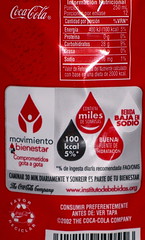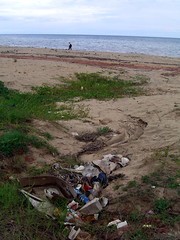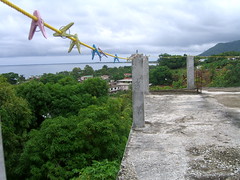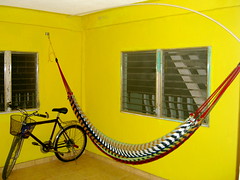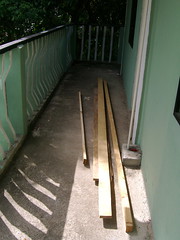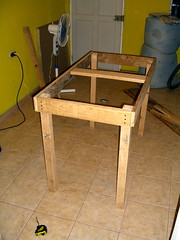![]() Six months ago tonight, I and about 25 other bleary-eyed peace corps trainees and boarded a bus in Georgetown and headed for Reagan International Airport. We flew to Atlanta, and from Atlanta to San Pedro Sula. And so began the Peace Corps Experience. It was supposed to start a few days earlier, but we were snowed in for a while. Now I'm living on the Caribbean coast and barely even remember what it's like to feel cold. Time flies!
Six months ago tonight, I and about 25 other bleary-eyed peace corps trainees and boarded a bus in Georgetown and headed for Reagan International Airport. We flew to Atlanta, and from Atlanta to San Pedro Sula. And so began the Peace Corps Experience. It was supposed to start a few days earlier, but we were snowed in for a while. Now I'm living on the Caribbean coast and barely even remember what it's like to feel cold. Time flies!
To celebrate, we've got a hurricane warning. Hurricane Dean is heading over this way, though so far the predictions have it tracking a bit north of us. Even so, it's expected to be Category 4 by Monday, so we could still get some heavy wind and rain. Exciting!
Friday, August 17, 2007
6 Months and a Hurricane
Posted by
Raphael
at
9:29 AM
0
comments
![]()
Tuesday, August 14, 2007
Coke Label
Movement
Well-being
Promised drop by drop
100 Calories (5%*)
Contains thousands of smiles
Good source of hydration
Low-Sodium Drink
* % of daily recommended allowance of FAO/OMS (WHO)
Walking 30 minutes daily and smiling is part of your well-being.
The Coca-Cola Company: www.institutodebebidas.org
Is this label on American cokes? I suppose none of this is a lie (thought the hydration claim is pushing it), but it's certainly misleading. And it works. Many people in Honduras actually believe that Coke is good for you.
Posted by
Raphael
at
12:32 PM
1 comments
![]()
A Moment in Trujillo
Walking back from English class on a hot, muggy night, my clothes stick to my sweaty skin. People are out and about in Cristales, walking, talking, sitting on doorsteps, illuminated by passing headlights and the occasional streetlamp. I cross the bridge to the road that runs along the beach and am treated to a spectacular view: a lightning storm over the Bay of Trujillo. Bolts of lightning streak across the sky, lighting up the clouds and reflecting off the black waters of the bay. I stop and watch one of the most spectacular fireworks displays I've ever seen.
Posted by
Raphael
at
12:21 PM
0
comments
![]()
Wednesday, August 8, 2007
Peace Corps on the Radio
One of my favorite talk radio shows, KQED's Forum, spoke with the director of the Peace Corps in their latest show. There is a link on their website to stream the show or download the MP3. You can also subscribe to the podcast with iTunes.
I haven't listened to the show yet (the connection from the internet café is painfully slow today) but as soon as I do I'll post my reactions.
Posted by
Raphael
at
2:52 PM
0
comments
![]()
Tuesday, August 7, 2007
Trash, Trash, Everywhere
Is it simple a lack of education and socialization that causes this? Partly, yes. Parents litter and kids copy their parents. But as with most problems in Honduras, the full answer is more complicated. The litter problem in Trujillo is a microcosm of the development challenges in Honduras as a whole.
In Trujillo we have municipal garbage collection in and around the center of town. There are public garbage cans on almost every street corner in a three block radius around the central park. That area of town (where there are garbage cans and weekly collection) is much cleaner than the rest of Trujillo. Most places in Honduras (even big cities) do not have public trash cans or regular garbage collection. It's like living in a city where the sanitation workers are permanently on strike, and hooligans have stolen all of the trash cans from the street corners. The images coming out of Oakland during their recent garbage strike showed how important these services are.
Of course, in Oakland the trash was piling up in specific areas (in and around overflowing dumpsters and trash cans). In general, people were putting the trash where it was supposed to go. Here in Trujillo, I've seen people toss empty soda cans into the street when they were less than 10 feet from a trash can (and don't even get me started on recycling). What is the solution to this? Some would say that it's the responsibility of parents to teach their kids how to behave like responsible citizens. I agree, but what should a society do when private citizens are failing to get the job done? That is when the government should use its resources to promote socially responsible behavior. Providing the cans and collection services is a definite prerequisite. On top of that, a carrot-and-stick campaign of education and enforcement should be waged to get people to change their behavior.
But here in Honduras, that is anything but simple to do. There's a sign on a bridge in Cristales that reads, "Don't throw garbage in the river. 1,000 Lempira fine." The banks of the river right below that sign are literally buried under garbage. As far as I can tell, this sign is the entire anti-littering campaign by the local government. There are no PR or education campaigns, and there is no enforcement of littering laws. Why is there no enforcement? Well, first of all, there is no blanket anti-littering law for the municipality, or if there is then nobody knows about it. Secondly, police officers don't patrol the city, so they can't spot litterbugs and cite them. Even if the police officers did patrol and cite people, hardly anyone could pay even a modest fee, and the paperwork overhead would swamp the officers. Most likely, it would become another way to for the police to extract bribes.
Lastly, there seems to be no political will to actually implement hard-hitting measures to effect change. Mayors often spend most of their time currying favor with influential citizens through backroom quid pro quo deals. They spend the entire year before the election campaigning and spreading money around to garner key endorsements. This leaves little time or money for projects that would actually improve life for the majority of citizens.
There are no doubt even more barriers to resolving the litter problem than the ones I can see. And this is just littering. Much deeper and more serious problems exist with security, education, health, and poverty. The interconnectedness of the causes and effects of these problems is so great that it just makes your head spin.
Posted by
Raphael
at
12:47 PM
4
comments
![]()
Sunday, August 5, 2007
DIY
Recently, I've been spending a lot of my free time on do-it-yourself projects, big and small.
Shortly after moving in to my apartment, I did a load of laundry and hung it to dry on the clotheslines behind my apartment. In the late afternoon, I came down to collect my clothes. My socks were missing. Someone had stolen them. Luckily I brought plenty of socks with me, so it wasn't a huge loss. But I realized that I couldn't dry my clothes out there unless I wanted to eventually lose my entire wardrobe. What to do?
Brent suggested an obvious solution: run a clothesline on my roof. Almost all Honduran buildings are built in a piecemeal fashion: one room or one floor at a time, whenever there is money for materials. (Interest rates on home loans are often 30% or higher, so people don't usually get financing for buying/building homes). Because of this, there's always rebar and extra pillars sticking out of the roof, ready for the time when the owner might eventually add on to the building. It was simple enough to string a rope along from rebar to rebar, and there was my new clothesline. I've had no problem with disappearing clothes since then.
On a trip to Tela a few weeks ago, I bought a hammock. I had never mounted a hammock before, and didn't really know what I needed. First I looked up the spanish words for hooks, screws, mounts, drill bit, etc, and wandered over to the hardware store. I walked out of there with everything I needed, and with the help of a power drill borrowed from Brent, I now have a hammock in my living room!
The biggest project so far has been furniture building. This past week I built my first piece of furniture: a table. I looked online for different table plans, and ended up adapting the plans from a workbench (it was the simplest and most sturdy-looking). I bought about 300 lemps of wood from the lumber yard, and cut them up with a handsaw (also borrowed from Brent). This took a looooong time. But after a couple days, I screwed all the pieces together, and whallah! A sturdy living room table.
Here are my plans, for those interested:
Raw supplies
(1) 2"x2" 14' long
(2) 1"x6" 10' long
(1) 1"x4" 14' long
Cut four legs from the 2"x2". I made my legs 33" long, which is about the height of a tall dining table. Cut the 1"x4" into three 2' long pieces and two 4' long pieces. Cut the two 1"x6" boards into eight pieces 2.5' long.
Start making the frame by screwing together two legs with one 2' piece of 1"x4".
Complete the frame by joining the legs with the 4' lengths of 1"x4". Screw in the remaining 2' piece of 1"x4" as the center support.
Line up the 1"x6" pieces on top, and screw them in to make the tabletop.
All done!
Posted by
Raphael
at
2:19 PM
3
comments
![]()
Chinese Peace Corps
I was reading the July 7-13 issue of the Christian Science Monitor World Edition (they give free subscriptions to Peace Corps Volunteers) and spotted this interesting article: Young Chinese vie to join their 'peace corps'.
China has just started a pilot volunteer program with 50 young men and women in three countries. They plan on expanding this to 300 volunteers by 2009. The article is a good read, and the two volunteers interviewed say things that many Peace Corps volunteers say. I definitely related to this passage about volunteer Sun Yingtao in Ethiopia:
During his time in Asossa, he has lost 10 pounds, and, he says, pulling up sleeves and pant legs to prove his point, received 188 bug bites.
I feel your pain, Sun.
Posted by
Raphael
at
2:18 PM
0
comments
![]()




